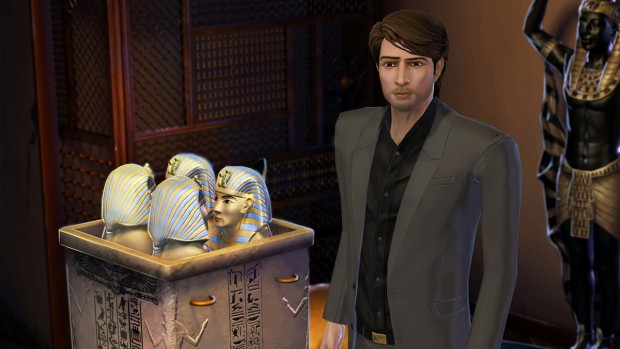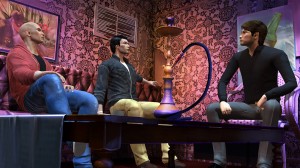Moebius Hands-on Preview
- Updated: 29th Jul, 2013

Malachi Rector is a very successful antiques appraiser. His eidetic memory and keen attention to detail make him the perfect recruit for an agency sifting through connections across the grand scheme of humanity. Problem is, he’s a bit of an asshole as a protagonist, and not in that sexy, bad boy way.
I really wanted to like Moebius. I absolutely adored Jane Jensen’s 90’s Gabriel Knight series, so the news of another supernatural adventure game from her studio was welcome. (I never played Gray Matter)
But the first chapter is just so dull. Malachi is gloomy and snobbish, lacking the easygoing charm of Knight, the hilarious snark of Grace Nakamura or any other entertaining characteristic that would make me want to spend 10-odd hours with him. He just wanders around with his interminably slow animations, being rude to people and refusing to dive into a river to for an object that I know is absolutely crucial to the plot.
Yeah, I got stuck on an inventory puzzle in the first chapter of a point-and-click adventure. What else would you expect? But this problem is exactly why I found Malachi’s snobbishness so annoying. I’m travelling from room to room, examining everything I can click on in the hopes that I find something I missed the first half-dozen times. Instead of helpful information, I get “Boring”, “Boring”, or “Boring”, over and over again. I know it’s boring, Malachi. I’m bored too. No need to make it worse.
There’s a hints system that provides unhelpful information, mostly telling you to open the object you can’t open, or pick up the object you can’t yet reach. More usefully, holding down the space bar or clicking on a menu button highlights all usable objects in a room. Once I discovered this, the solution was obvious. As you might expect, I had mistaken a crucial object for background dressing.
Malachi is prized for his ability to observe tiny details, so you have the option to analyse every major character you meet. Click the brain icon and the game will present you with an image of that person. It’s up to you to play Sherlock, noticing all the pertinent details that could lead to new dialogue options.
In practice, however, these critical details look just like every other part of the character and there’s no rhyme or reason to what’s important. A pattern would be useful – examine the head, face, clothes, fingers, shoes, etc. But that’s not the case – sometimes you need to click the head and the face. Sometimes the left shoulder will reveal a muscular physique but the right shoulder will not.
 Eventually, you’ll realise that it’s easier to just frantically click all over their body, searching for that elusive last hotspot which could be an invisible tear in their jacket, or a mouth that’s “always smiling, moving: dishonest, a liar” which you’re somehow expected to notice on a static image.
Eventually, you’ll realise that it’s easier to just frantically click all over their body, searching for that elusive last hotspot which could be an invisible tear in their jacket, or a mouth that’s “always smiling, moving: dishonest, a liar” which you’re somehow expected to notice on a static image.
The puzzles aren’t engaging either. A darts match is available to win the trust of one of these men. It doesn’t take a genius to figure out that the nearby vent blows the darts off course, nor that when Malachi can’t reach the off switch, he should drag over the wooden crate that sits nearby.
During chapter two, Malachi wishes to find out more about a man he’s supposed to meet. Rather than, say, talking to the receptionist at the hostel next door, all I can do there is walk away. I detest this arbitrary restriction – a simple “I’ve seen him around but we’ve never spoken” would do wonders for the feeling of freedom. Instead, I feel like I’m struggling down the designer’s path, tripping over invisible obstacles at every turn.
The premise behind Moebius is intriguing – Malachi is initially hired to find connections between a recently-murdered woman and a famous figure from history. Presumably the repeating patterns will relate in some way to the Moebius strip evoked by the game’s title. Sad to say that I can’t stand the world long enough to find out.

8 Comments